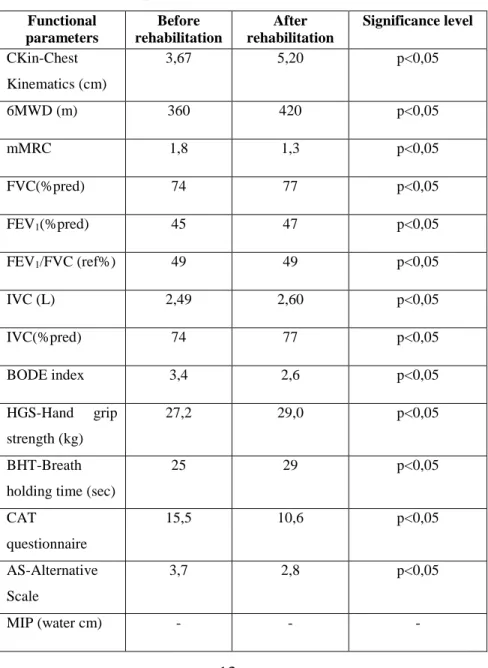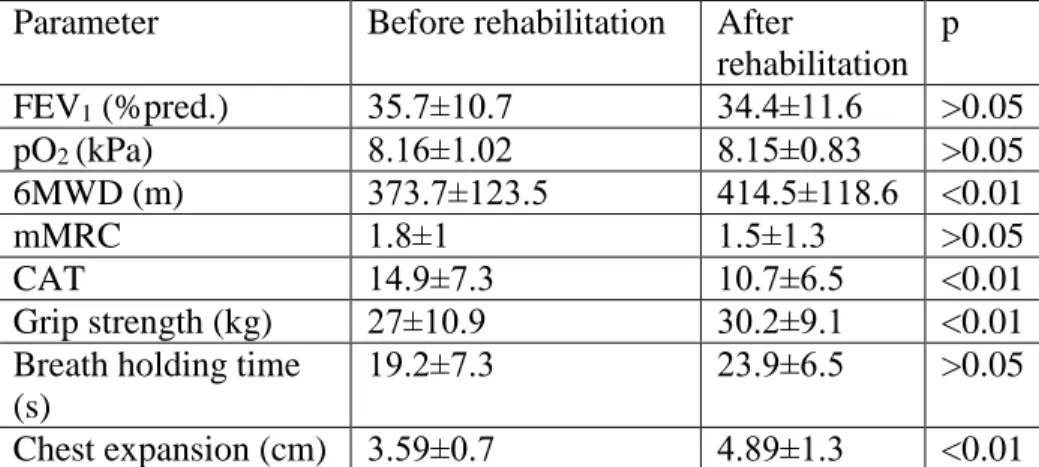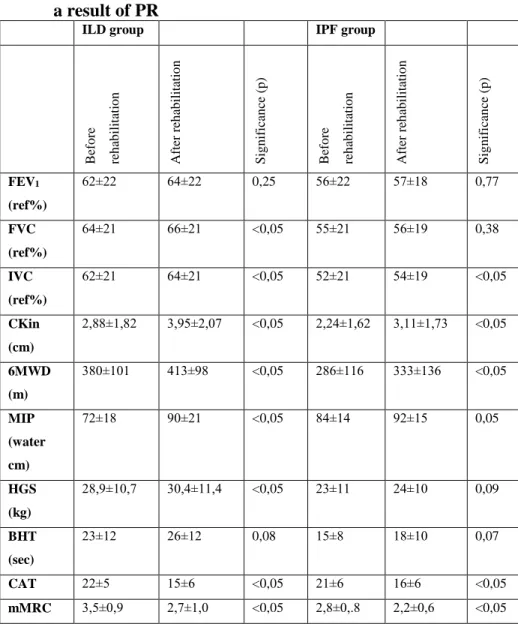The correlation between exercise tolerance and other functional parameters in COPD and Interstitial lung
desease
PhD Thesis Kerti Mária
Clinical Medicine PhD School Semmelweis University
Supervisor: Janos Tamas Varga MD, PhD Official reviewers: Reka Gajdocsi MD, PhD
Csaba Mathe MD, PhD Head of Complex Examination Committee:
Zoltan Benyo MD, DSc Members of Complex Examination Committee:
Barna Vasarhelyi MD, DSc Andras Folyovich MD, PhD
Budapest 2019
1 1. Introduction
Chronic obstructive pulmonary disease (COPD) and interstitial lung desease (ILD) are chronic diseases, which result in unfavourable changes in lung mechanics. These changes occur in chest kinematics and diaphragm force.
In healthy patients, diaphragm is the main coordinator of lung mechanics, providing the pump function, playing an important role in breathing mechanics. In inspiration, the external ribcage muscles and the diaphragm contract, the diaphragm moves downwards, increasing the sagittal diameter of the chest. The side fibres of the diaphragm and the external ribcage muscles increase the transversal diameter of the chest.
In expiration, the diaphragm fibres relax, the diaphragm moves upwards, the abdominal muscles and internal ribcage muscles - the active faciliators of expiration - contract. More relaxation of the striated muscle can result more powerful next contraction.
According to this rule, expiration helps inspiration - if we can exhale longer, the diaphragm can be more relaxed and its fibres`s strech can reduce, the next inhalation can be more powerful.
Chest movement determines the length of diaphragmic fibres. In healthy patients, diaphragm pressure, fibre contraction’s speed
2
and work endurance can increase considerably, adapting to the increased workload.
In COPD, as a result of dynamic hyperinflation (DH), lung mechanics (LM), chest kinematics (CKin), and the normal anatomic position and the track of the diaphragm change. As a consequence, both the end-expiratory lung volume (EELV) and the residual volume (RV) increase. The patophysiological changes in lung mechanics decrease the strength and endurance of the diaphragm. Because of the decreased expiratory flow (obstruction) and expiratory pressure (emphysema) the diaphragm is fixed in inhalation position, its relaxation and movement is considerably limited. This results in decreased muscle force. Based on the less force of the diaphragm, exercise tolerance (6MWD) decreases and dyspnoe increases. DH correlates with the severity of obstruction (GOLD-stadium).
Obstruction and hyperinflation can result decrease in ventilation.
Pulmonary function tests show that residual volume (RV) and functional residual capacity (FRC) increase, inspiratory volume capacity [IVC(L)] decreases, the resistance of airways increases.
The presence of trapped air is indicated if total gas volume (TGV) is higher than total lung capacity (TLC).
Interstitial lung desease (ILD) means a group of chronic illnesses, which can be progressive with time. In ILD, despite
3
medical treatment, patiens’ life span does not grow significantly.
Chest physiotherapy and pulmonary rehabilitation (PR) can effectively contribute to complex treatment, but there is little data concerning this effect in the international scientific literature. The decreased strength and mobility of the diaphragm can occur in ILD, as it is a chronic desease. CKin also decreases in ILD, because breathing pattern becomes pathophysiological as a consequence of hyperventilation.
In both chronic respiratory diseases, the strength and endurance of the diaphragm falls. This results decrease in IVC(L), because the diaphragm is the primary inspiratory muscle. In COPD, diaphragm strength is lowered by DH as well.
In ILD, inspiratory capacity is also limited by pulmonary fibrosis.
Pulmonary rehabilitation significantly increases exercise tolerance in patients with COPD and ILD. LM and Ckin can improve, the organs obtain more oxygen, exercise tolerance and diaphragm force increase, DH can decrease in COPD.
Endurance training improves tissue perfusion, positively affecting peripherial muscles and metabolism.
PR results improvement in exercise tolerance in patients with COPD and ILD, which can be measured by 6MWD.
However, the correlation between 6MWD and other functional
4
parameters (FP), such as LM, CKin, metabolism, breathing and peripherial muscle function - which affect exercise tolerance - is unknown.
It is important that patients with chronic diseases regain their ability to go back to work as soon as possible, and preserve this ability as long as possible in the best possible functional state.
This generates considerable benefits at a social level, as well.
Support and funding from healthcare policy makers is essential to achieve these goals.
2. Objectives
2.1. COPD group
Question 1: Can exercise tolerance be improved and DH reduced by PR in COPD?
Question 2: What is the correlation between 6MWD/IVC(L) and other FPs?
Question 3: Can quality of life be improved by this complex program?
Question 4: Can we influence LM and CKin in a positive way?
5
Question 5: Does PR reduce the severity of the disease?
Question 6: Can breathing and peripherial muscle function be improved by PR?
2.2. ILD group
Question 1: Is there a difference between the improvement of ILD and IPF patiens, as a result of PR?
Question 3: What correlations can be found between exercise tolerance and other FPs, and inspiratory capacity and other FPs?
Question 4: Can patients’ exercise tolerance and quality of life be improved?
Question 5: Can LM and CKin be improved?
Question 6: Can respiratory and peripherial muscle functions improve by PR?
6 3. Methods
The study was carried out in the Department of Pulmonary Rehabilitation, National Koranyi Institute for Pulmonology (OKPI). In two patient groups (COPD, ILD) it was examined how PR improved exercise tolerance and quality of life, how different FPs correlated with 6MWD and IVC(L).
In the COPD group, besides calculating BODE index, we created Alternative Scale (AS), which, similarly to BODE index, can determine the severity of the illness. In AS, instead of mMRC-dyspnoe test results, we included CAT test results.
In the ILD group, we established the IPF subgroup, examining whether the effect of PR is different there. We examined the relationship of FPs and 6MWD/IVC(L).
3.1. Patients
3.1.1. The COPD group
In the first clinical study 327 COPD patients were included.
[age: 64±8 years, male/female: 181/146, BMI: 27±7 kg/m2, FEV1(ref%): 45±19] The examination was retrospective.
Patients took part in the rehabilitation programme between 2014
7
and 2017 in the Department of Pulmonary Rehabilitation, National Korányi Intitute for Pulmonology (OKPI). Every patient signed a statement of agreement and the study was approved by the Research Ethics Committee of National Koranyi Institute for Pulmonology (OKPI IKEB), approval number: 25/2017. The study was accepted in the International Standard Randomized Controlled Trial Number (ISRCTN) system, registration number: ISRCTN13019180 ID. In the second clinical study 19 COPD-patients were included [age:
64±9 years, male/female: 11/8, BMI: 23±4 kg/m2, FEV1(ref%):
(36±11].
3.1.2. ILD-IPF group
In ILD-IPF-group participated 53 patients [ILD-group: n=30, age: 54±8 years, male/female: 17/13, BMI: 28±6 kg/m2, FVC(ref%): 64±21, IPF-group: n=23, age: 45±9 years, male/female: 12/11, BMI: 27±5kg/m2, FVC(ref%): 54±21] They took part in the rehabilitation programme beetween 2014 and 2017. Patients signed a statement of agreement. (OKPI IKEB approval number: 25/2017). The study was accepted in the ISRCTN system, registration number: ISRCTN13019180 ID.
8
3.2. The pulmonary rehabilitation programme and the examined FPs
The rehabilitation programme usually took 4 weeks. FPs of patients were checked before and after completing the programme (table 1.). The FP values before and after the programme were compared in order to establish the effect of PR.
Patients took part in a daily 30-minute group exercise session including controlled breathing technics, exercises improving MKin, muscle force and chest wall streching exercises. These group exercises positively affect LM and CKin. Patients did individual endurance training on exercise bycicles and treadmill 2 or 3 times a day, for 15-20 minutes also, which was set considering the severity of their illness, physical state measurements and comorbidities. Endurance training can improve the condition of patients due to its beneficial cardio- vascular effect. This means that pulse lowers and oxigen saturation improves in izotime conditions (identical power).
Endurance training was carried out either in form of continuous trainig (CT), or interval training (IT). Patients also used various respiratory devices (Power Breathe, Shaker delux Flutter) chosen for them individually. Smokers were recommended a programme designed to help to quit smoking (Erika Pataki help
9
it in our intitute), which can be an integral part of any rehabilitation programme, improving mucociliar function, pulmonary function and quality of life.
10 Table 1. Functional Parameters
6MWD 6 Minute walking distance MIP (Maximal inspiratory pressure) CK (Chest kinematics)
FVC(%pred) FEV1(%pred)
IVC(L) (Inspiratory vital capacity) IVC(ref%) (Inspiratory vital capacity) HGS (Hand grip strength)
BHT (Breath-holding time)
mMRC (Modified Medical Research Council) dyspnoe scale CAT (COPD Assessment Test)
BODE index
AS (Alternative Scale)
3.3. Process of data, statistical analysis
Matematical-statistical analysis was based on the data from the excel sheet. Descriptive statistics was created (average, SD±), normal distribution was tested by Kolgomorov-Smirnov test.
With parameters not following normal distribution the non- parametrial two-sample t-test was used (Mann-Whitney test).
11
Pearson Chi-square test (χ²) was used to check the comparisons of groups. FPs were checked before and after rehabilitation, the change in parameters was statistically analysed, the significance of change was checked by paired t-test. Significance level was set at p<0,05, using Wilcoxon Signed test. Scatterplot distribution was analysed. In the COPD group we analysed the direction of change and significance. We calculated the correlation between different FPs, using Pearson correlation method. In the correlation matrix, every FP was checked against other FPs. We examined the correlation between 6MWD and other parameters. We also checked the correlation between IVC(L) and other FPs (the increase of IVC(L) indicates the decrease of DH).
In the ILD group we examined the similarities and differences between the IPF subgroup and ILD group.
4. Results
4.1. COPD group
In the first study, as a result of the PR programme, CKin, exercise tolerance, pulmonary functional and breathing mechanical parameters changed significantly and positively.
12
Functional parameters (except for MIP) improved significantly (table 2.). The change of MIP could not be established as this parameter was introduced later in our survey and some of the data was missing. Our complex rehabilitation programme also improved breathing and peripherial muscle function by positively affecting metabolism. PR significantly reduced DH, which limits both exercise tolerance and quality of life, thus improving both of these parameters.
13
Table 2. The change in FPs as a result of PR (1.
COPD-group)
Functional parameters
Before rehabilitation
After rehabilitation
Significance level
CKin-Chest Kinematics (cm)
3,67 5,20 p<0,05
6MWD (m) 360 420 p<0,05
mMRC 1,8 1,3 p<0,05
FVC(%pred) 74 77 p<0,05
FEV1(%pred) 45 47 p<0,05
FEV1/FVC (ref%) 49 49 p<0,05
IVC (L) 2,49 2,60 p<0,05
IVC(%pred) 74 77 p<0,05
BODE index 3,4 2,6 p<0,05
HGS-Hand grip strength (kg)
27,2 29,0 p<0,05
BHT-Breath holding time (sec)
25 29 p<0,05
CAT
questionnaire
15,5 10,6 p<0,05
AS-Alternative Scale
3,7 2,8 p<0,05
MIP (water cm) - - -
14
We examined how FPs correlated with 6MWD and IVC(L). We found that BODE index and AS correlated most with 6MWD, while KSZE, IVC(ref%) and FVC(ref%).correlated most with IVC(L) in the first COPD study.
In the second study our PR program resulted in significant improvement in 6MWD, CAT-questionnaire, HGS, ant CKin (table 3.).
Table 3. The change in FPs, as a result of PR (2. COPD- group)
Parameter Before rehabilitation After
rehabilitation p FEV1 (%pred.) 35.7±10.7 34.4±11.6 >0.05
pO2 (kPa) 8.16±1.02 8.15±0.83 >0.05
6MWD (m) 373.7±123.5 414.5±118.6 <0.01
mMRC 1.8±1 1.5±1.3 >0.05
CAT 14.9±7.3 10.7±6.5 <0.01
Grip strength (kg) 27±10.9 30.2±9.1 <0.01 Breath holding time
(s)
19.2±7.3 23.9±6.5 >0.05
Chest expansion (cm) 3.59±0.7 4.89±1.3 <0.01
4.2. ILD-IPF group
In this group we found significant improvement in IVC(L), Mkin, exercise tolerance and quality of life (table 4).
15
Table 4. The change of FPs in the ILD-IPF group as a result of PR
ILD group IPF group
Before rehabilitation After rehabilitation Significance (p) Before rehabilitation After rehabilitation Significance (p)
FEV1
(ref%)
62±22 64±22 0,25 56±22 57±18 0,77
FVC (ref%)
64±21 66±21 <0,05 55±21 56±19 0,38
IVC (ref%)
62±21 64±21 <0,05 52±21 54±19 <0,05
CKin (cm)
2,88±1,82 3,95±2,07 <0,05 2,24±1,62 3,11±1,73 <0,05
6MWD (m)
380±101 413±98 <0,05 286±116 333±136 <0,05
MIP (water cm)
72±18 90±21 <0,05 84±14 92±15 0,05
HGS (kg)
28,9±10,7 30,4±11,4 <0,05 23±11 24±10 0,09
BHT (sec)
23±12 26±12 0,08 15±8 18±10 0,07
CAT 22±5 15±6 <0,05 21±6 16±6 <0,05
mMRC 3,5±0,9 2,7±1,0 <0,05 2,8±0,.8 2,2±0,6 <0,05
16
Similarly to the COPD group, we examined in the ILD-IPF groups how 6MWD and IVC(L) correlated with other functional parameters. In this group the increase in IVC(L) was interpreted as the decrease of restriction, because - unlike in the COPD group - DH does not occur here. There is strong correlation between 6MWD and quality of life (CAT, mMRC) in both these groups. In the ILD group we also found strong correlation between 6MWD and ALVI. In the IPF group correlations were stronger. There was strong correlation between the improvement in 6MWD and the improvement in FEV1(ref%), HGS, CKin and FVC(ref%).
Further analysing the data, we examined correlation between 6MWD and FVC. In the IPF group correlation was stronger (R2=0,29) than in the ILD group (R2=0,001). This can be explained by the higher reversibility of lung mechanics in the IPF group.
17 5. Conclusions
5.1. COPD group
1. 6MWD improved significantly. Dynamic hyperinflation decreased, which could be seen from the increased IVC(L).
2. 6MWD showed the strongest correlation with BODE index, AS, mMRC, CAT test and IVC(L). IVC(L) correlated strongly with HGS, IVC(ref%), FVC, CKin,and BODE index .
3. Patients’ quality of life improved significantly. The non- significant improvement of dyspnoea can be related to the less number of patients in the second study.
4. Chest kinematics and lung mechanics could be influenced positively.
5. Severity of illness decreased as BODE index and AS results improved.
6. Improvement in breathing muscle force could not be justified, while peripherial muscle force improved.
18 5.2. ILD-IPF group
1. In the ILD group there was a significant improvement in FVC(ref%), IVC(ref%), CKin, 6MWD, MIP, HGS, and the results of the quality of life questionnaires (CAT, mMRC).
In the IPF group we experienced considerable positive change in IVC(ref%), MK, 6MWD, MIP, and the results of the quality of life questionnaires (CAT, mMRC).
2. Patients in the two groups reacted differently to the PR programme. In the ILD group 6MWD correlated less strongly with FVC(ref%), IVC(ref%), HGS, and CAT results than in the IPF group. This proves that patients in the IPF group show higher reversibility in terms of lung mechanics.
3. In the ILD group 6MWD correlates most with mMRC, CAT test results and BHT, while in the IPF group correlations proved stronger with mMRC, CAT, FEV1(ref%), HGS, CKin and FVC(ref%). In the ILD group, IVC(L) correlates most with HGS, IVC(ref%), FVC(ref%), BHT and FEV1(ref%), while in the IPF group IVC(L) correlates most with CKin, FEV1(ref%), BHT, FVC(ref%), CAT results, HGS, mMRC and FEV1/FVC(ref%).
19
6. Bibliography of the candidate’s publications
6.1. Publications related to the PhD thesis
1. Kerti M, Balogh Zs, Kelemen K, Varga JT. The relationship between exercise capacity and different funktional markers in pulmonary rehabilitation for COPD 2018.
Int J of Chron Obstruct Pulm Dis. 13 pp.717-724. (2018).
IF:2,917.
2. Pako J, Balogh Zs, Kerti M, Drozdovszky O, Bikov A, Antus B, Horvath I, Varga J. Assessment of the Anti-Aging Klotho Protein in Patients with COPD Undergoing Pulmonary Rehabilitation.
COPD-Journal of Chronic Obstructive Pulmonary Disease.
14(2):p.176-180. (2017).
IF:2,604.
3. Kerti M, Kelemen K. Varga JT. The effectiveness of Pulmonary Rehabilitation in Comparison Interstitial Lung Diseases and Idiopathic Pulmonary Fibrosis
J of Pulm & Respir Med. 8:(5) 1000475. 5p (2018).
20
6.2. Presentations unrelated to the PhD thesis
1. Vagvolgyi A, Rozgonyi Zs, Kerti M, Agathou G, Vadasz P, Varga J. (2018) Effectiveness of pulmonary rehabilitation and correlations in between functional parameters, extent of thoracic surgery and severity of post-operative complications:
randomized clinical trial.
J Thorac Dis 2018;10:(6) pp. 3519-3531. (2018).
IF:1,804.
2. Vagvolgyi A, Rozgonyi Z, Kerti M, Vadasz P, Varga J.
Effectiveness of Perioperative Pulmonary Rehabilitation in Thoracic Surgery.
J Thor Dis 9:(6) p. 1584-1591. (2017).
IF:1,804.


